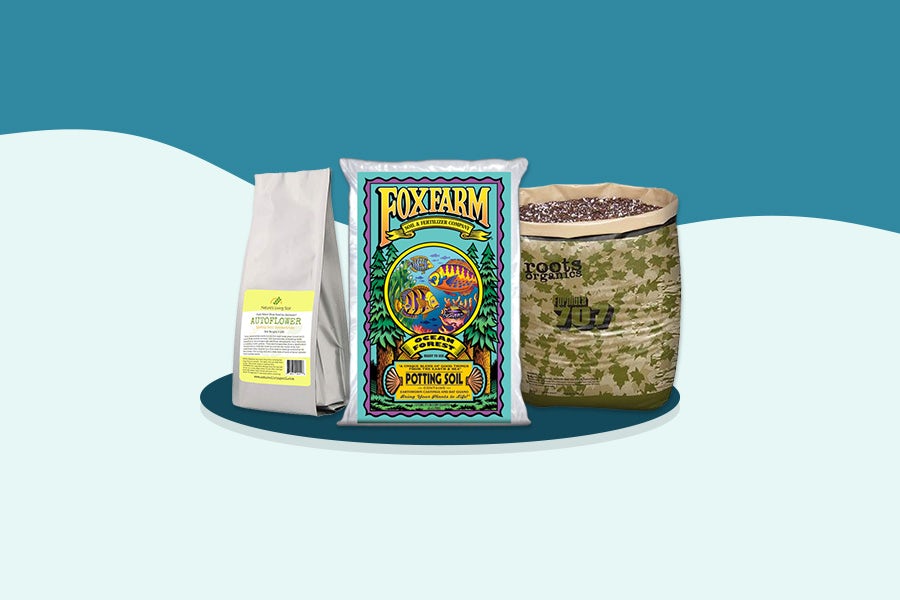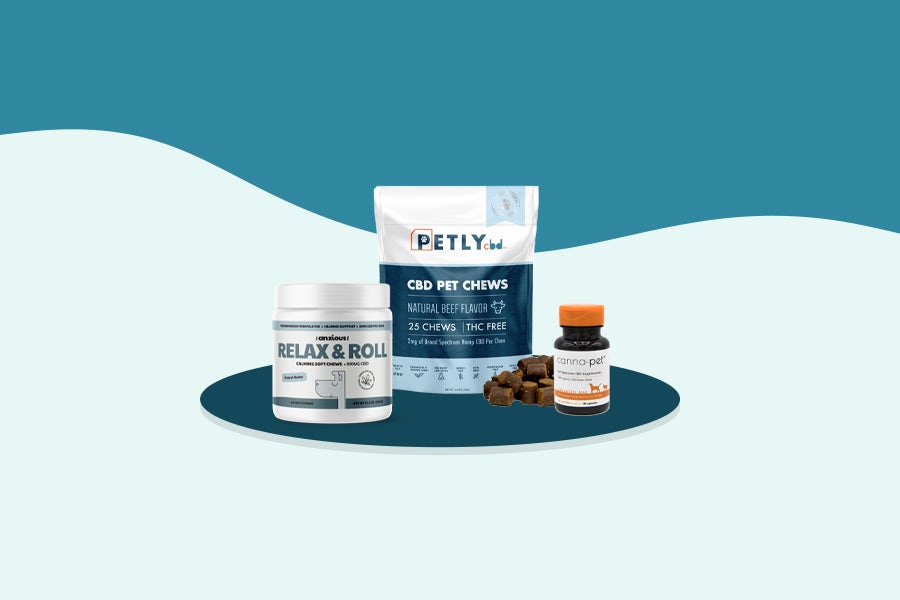Soil is the root of all plant life…because it literally feeds the roots! Sure, you could use hydroponics to grow cannabis, but despite the extra work, hydroponic systems don’t appear to improve cannabis plant growth or potency over soil which is the tried and true growing medium for marijuana. Despite soil’s relative lack of precision compared to hydroponics, it remains the preferred medium for numerous seasoned cannabis cultivators – and is obviously the way nature intended, as cannabis was growing wild long before humans started domesticating it. 1 2
While many home-growers admire soil, few cultivators can agree on the best soil for growing cannabis. Finding the perfect balance of nutrients, aeration, and water retention can take some time for new and even professional growers to figure out. Not to mention the numerous variables that can influence which soil is ideal, including watering and feeding patterns, types of grow-container used, and even the origin of the variety (or strain) being grown. Thankfully, plenty of high-quality cannabis soil preparations are now available for growers with all different cultivation styles.

-
 Suitable for potted plants that are moderate to heavy feeders
Suitable for potted plants that are moderate to heavy feeders
-
 Indoor or outdoor
Indoor or outdoor
-
 Price: $16.99 - $700+, depending on size
Price: $16.99 - $700+, depending on size

-
 Suitable for potted plants
Suitable for potted plants
-
 Indoor or outdoor
Indoor or outdoor
-
 Price: $16.99 - $700+, depending on size
Price: $16.99 - $700+, depending on size
-
 Suitable for potted plants
Suitable for potted plants
-
 Indoor or outdoor
Indoor or outdoor
-
 Price: $16.99 - $700+, depending on size
Price: $16.99 - $700+, depending on size

-
 Specialized for autoflowering seeds
Specialized for autoflowering seeds
-
 Indoor or outdoor
Indoor or outdoor
-
 Price: $24, $43, or $68
Price: $24, $43, or $68
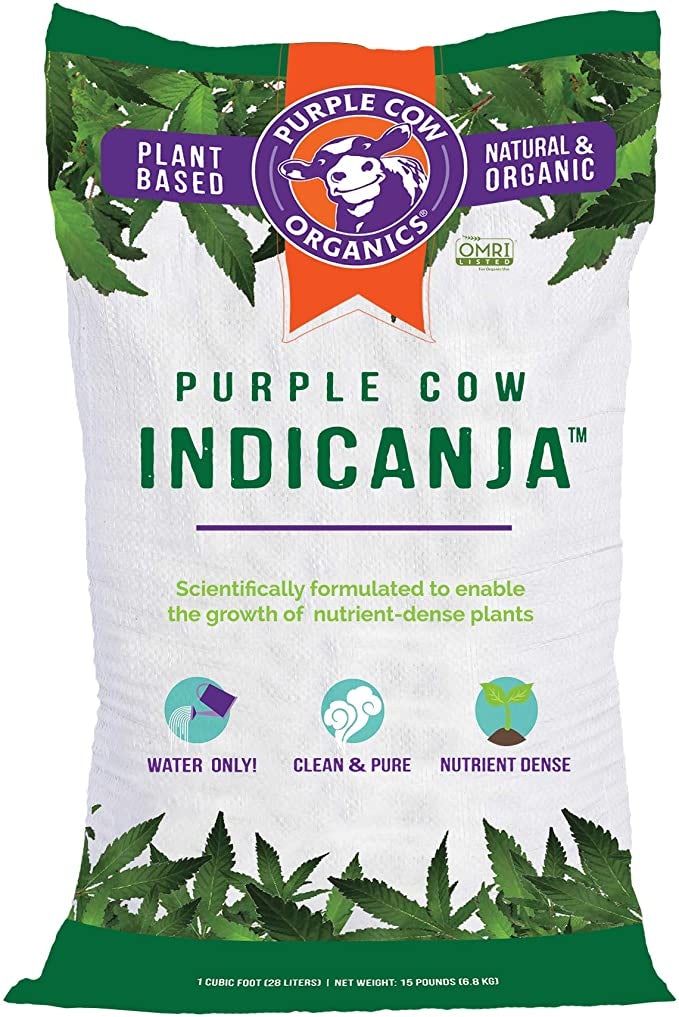
-
 Suitable for potted plants
Suitable for potted plants
-
 Indoor or outdoor
Indoor or outdoor
-
 Price: $35.00
Price: $35.00
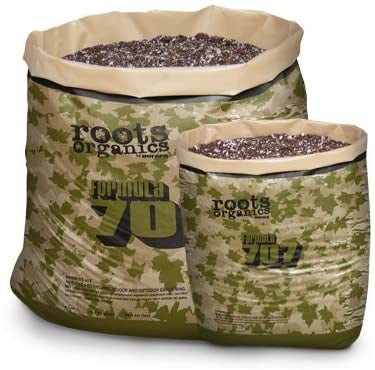
-
 Suitable for large-container plants
Suitable for large-container plants
-
 Indoor or outdoor
Indoor or outdoor
-
 Price: ~ $40 - $75
Price: ~ $40 - $75

-
 Suitable for potted plants
Suitable for potted plants
-
 Indoor or outdoor
Indoor or outdoor
-
 Price: ~ $75
Price: ~ $75
Ocean Forest Potting Soil
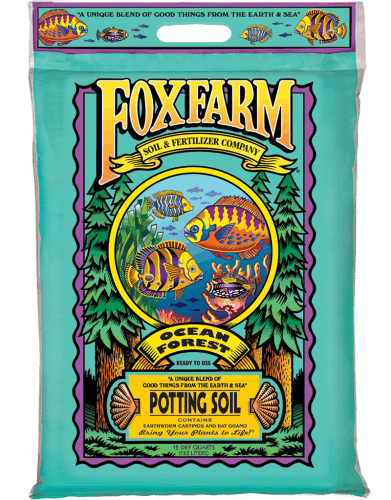
- Suitable for potted plants that are moderate to heavy feeders
- Indoor or outdoor
- Sizes: 12 quart, 2 cubic foot, 27 cubic foot tote, or 55 cubic foot tote
- Not organic
- Price: $16.99 – $700+, depending on size
Special features:
- contains additions like fish emulsions and crab meal for high nutrient density
- one of Fox Farm’s most nutrient-dense potting soils
- full of rich soil amendments like bat guano, crab meal, and fish emulsions
Of Fox Farm’s many best-selling mixes, Ocean Forest usually ranks as the company’s best potting soil for cannabis. This soil formula is more nutrient-dense than Happy Frog, which makes Ocean Forest less reliant on supplemental nutrients. While this could pose problems for young plants, it will help vegetative plants grow to their full potential.
Ocean Forest gets its name from its high concentration of amendments like fish emulsion and crab meal. Ocean Forest’s formula makes nitrogen deficiencies nearly impossible with plenty of earthworm castings and bat guano.
You may need extra nutrients during flowering, but it’s essential to have a light hand when using supplements. Ocean Forest is “hotter” than other potting mixes, so it’s best to cut your recommended feeding schedule by at least half.
If cultivators find Ocean Forest is too hot to handle, they may want to dial it back with milder formulas. For instance, many people enjoy combining Ocean Forest with Happy Frog. Once people learn to use Ocean Forest, they often rave about its performance.
Happy Frog Potting Soil
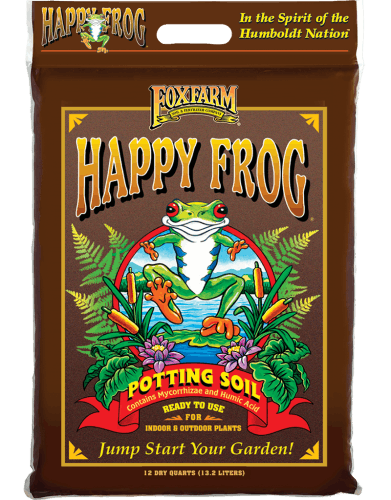
- Suitable for potted plants
- Indoor or outdoor
- Sizes: 12 quart, 2 cubic foot, 27 cubic foot tote, or 55 cubic foot tote
- Not organic
- Price: $16.99 – $700+, depending on size
Special features
- well-balanced
- mild potting soil ideal for beginners
One of Fox Farm’s “less hot” potting soils, ideal for delicate seedlings.
Excellent soil for beginners who don’t mind adding supplemental nutrients.
Makes it easy to avoid overfeeding and “nutrient burn.”
The Happy Frog Potting Soil is considered one of Fox Farm’s “weaker” soil formulas, but that’s not a criticism! Unlike Ocean Forest, Happy Frog focuses on the beginning stages of growth when plants can’t handle excessive nutrients.
Many cultivators use Happy Frog to give their seedlings a safe space to mature. While Happy Frog has additions like earthworm castings and bat guano, you’ll need to add nutrients as cannabis gets into the vegetative stage.
The allure of Happy Frog is in its simplicity. New growers often have the best time with this soil because they can easily follow their supplemental nutrients’ guide.
Anyone who fears they’ll “overfeed” their cannabis plants should start with a bag of Happy Frog. As you gain more experience with cultivation, consider mixing Happy Frog with more fertilizer-rich formulas during flowering.
Fox Farm “Bush Doctor” Coco Loco

- Suitable for potted plants
- Indoor or outdoor
- Sizes: 12 quart, 2 cubic foot, 27 cubic foot tote, or 55 cubic foot tote
- Not organic
- Price: $16.99 – $700+, depending on size
Special features:
- rich traces of coco coir provide high-quality pest resistance and water retention
- high coco coir formula with plenty of nutrient-rich amendments
- superior water retention and pest resistance
As its name hints, Fox Farm’s Coco Loco formula largely consists of the inert medium coco coir. Unlike plain potting soil, coco coir only has noteworthy traces of potassium. In fact, coco coir is often viewed as a “stepping stone” medium for those transitioning from soil to hydroponics.
While not every grower is a fan of coco coir, it has many excellent features like water retention and pest resistance. Plus, since Fox Farm’s Coco Loco adds ingredients like kelp, bat guano, and earthworm castings, there’s less need to fear nutrient deficiencies.
With Coco Loco, you get the benefits of growing in coco coir without having to significantly adjust your feeding schedule. You may, however, need to tweak your watering schedule, especially if you don’t add perlite which aids in aeration, allowing more oxygen to get to the roots. Coco coir retains moisture more than other mediums, so please resist the urge to overwater!
Nature’s Living Soil Autoflower Concentrate

- Specialized for autoflowering seeds
- Indoor or outdoor
- Sizes: 1 lb., 5 lbs., 10 lbs.
- Organic
- Price: $24, $43, or $68
Special features:
- rich collection of amendments and microorganisms well-suited for autoflowering plants
- includes high quality additions ranging from bat guano to bone meal
- easy to add to regular potting mix for extra root support
Want to create a “super soil” in the shortest amount of time? Try adding Nature’s Living Soil’s Autoflower Concentrate to a generic potting mix.
This well-reviewed soil amendment is so potent you only need to add one pound per five-gallon container. Nature’s Living Soil promises its signature product is “pre-cooked” and contains dozens of beneficial bacteria for autoflowers.
Cultivators are impressed with the wide array of extra compounds like organic earthworm castings, fishbone meal, and kelp. The company also puts beneficial fungi in its formula, which may even give it a slightly “moldy” (but harmless!) appearance.
While Nature’s Living Soil’s Auto Concentrate may seem too hot (or nutrient rich), it’s recommended for all stages of an auto’s life cycle. So, if you want to give your autos a boost, it may be worth your while to mix in this unique concentrate.
Purple Cow IndiCanja Organic Living Soil
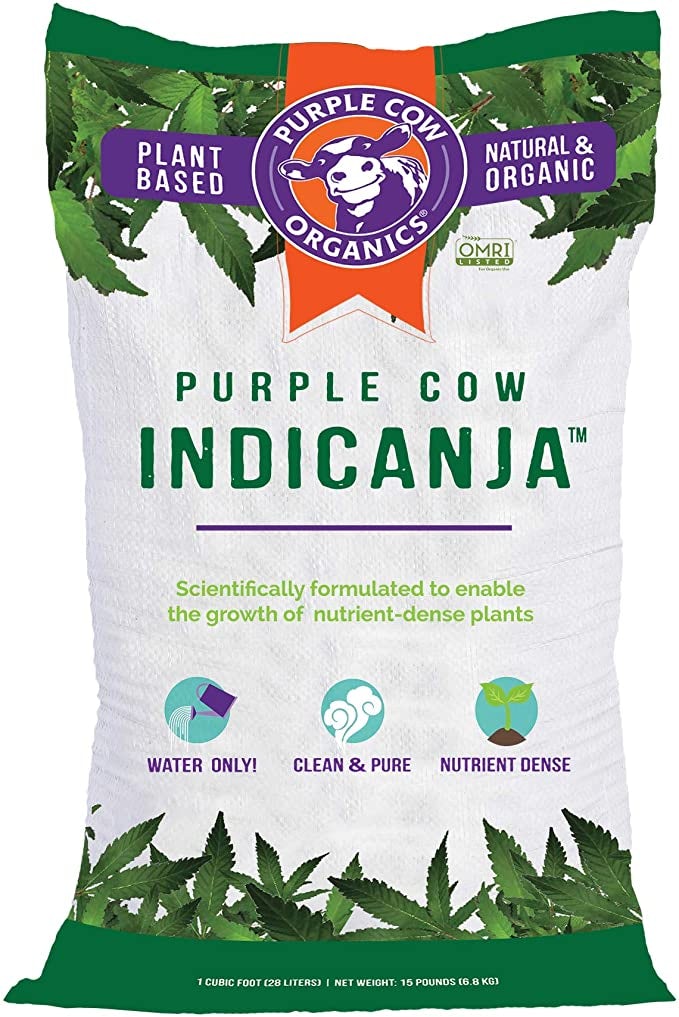
- Suitable for potted plants
- Indoor or outdoor
- Sizes: 15 pounds
- Organic
- Price: $35.00
Special features:
- organic, compost-based “super soil” mix
- premade “super soil” with dozens of beneficial microorganisms
- ultra-green organic formula made with compost
Purple Cow may not be as famous as Fox Farm, but it’s gaining attention with fans of “super soil.” This organic soil mix relies on compost to give it higher traces of bioavailable nutrients and bacteria.
According to Purple Cow’s founders, you won’t need any supplemental nutrients when planting your cannabis in this “living soil.” That’s right; just water your soil, and watch your plants grow! While IndiCanja Living Soil may be too intense for seedlings, it should be all you need for mature plants.
Experienced cannabis growers who are curious about “super soils” may want to experiment with Purple Cow’s Living Soil. While IndiCanja may not replace a DIY super soil, it’s far more convenient to try at home.
Roots Organics Formula 707

- Suitable for large-container plants
- Indoor or outdoor
- Sizes: 3, 10, and 20-gallon bags
- Organic
- Price: ~ $40 – $75
Special features:
- less nutrient-dense formula tailored for advanced growers
- low-nutrient potting soil that’s ideal for growers who enjoy mixing DIY formulas
- formula 707’s packaging doubles as a pot
Forget about the ingredients for a second; Roots Organics’ Formula 707 has one of the most fascinating packages. These large container bags could double as your cannabis plant’s pot. Simply cut off the bag’s top and put your plants in. Talk about convenience!
But Formula 707 is way more than its unique container. While this soil mix has fewer nutrients than other formulas, that’s on purpose. Roots Organic intended this formula to accommodate advanced planters who like to make DIY mixes.
You should have some experience adding fertilizers and amendments like perlite before opting for Formula 707. While this may not be optimal for beginners, it’s a worthy choice for cannabis cultivators who crave control.
Mother Earth Coco Plus Perlite Mix
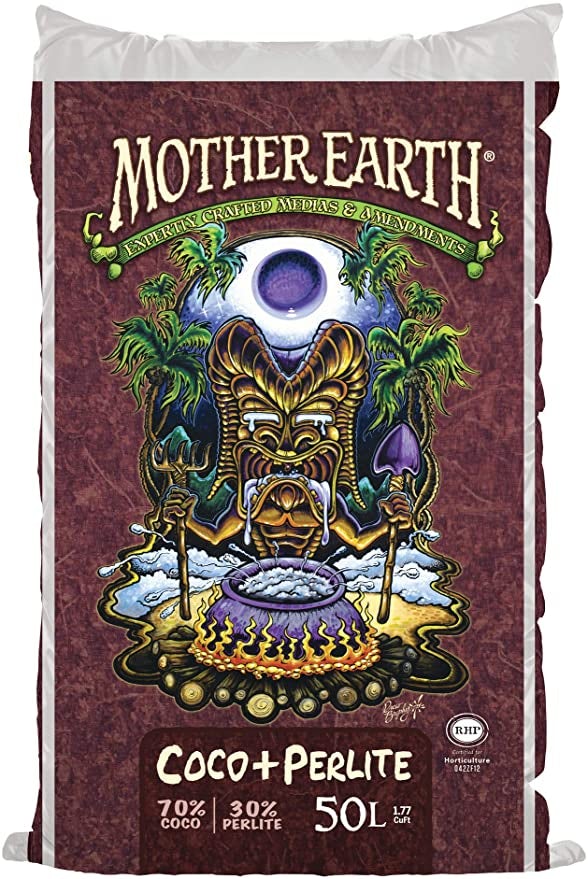
Suitable for potted plants
Indoor or outdoor
Sizes: 27 lbs.
Not organic
Price: ~ $75
Special features:
- pre-mixed formula of coco coir and perlite helps balance out drainage and water retention
- high coco coir formula that gives home-growers optimal control
- pre-mixed with 30 percent perlite for improved drainage
Like Fox Farm’s Coco Loco, Mother Earth’s Coco Plus Perlite Mix is an excellent choice for coco coir cultivation. This formula has the extra benefit of ~ 30 percent perlite, a useful component of soil which massively improves drainage, water retention and aeration.
While this formula is pretty “bare bones” (literally), that may suit growers who prefer adding macro and micronutrients. Indeed, anyone who struggles with “nutrient burn” may enjoy the superior control Mother Earth’s Coco formula provides.
Also, using coco formulas allows you to “test the waters” before opting for a hydroponics setup. Since coco coir is essentially an inert medium, it gives cultivators a taste of what hydroponics growing is all about.
What soil type is best for growing cannabis?
A quick tour of online weed forums will reveal many heated debates over the “best” soil for cannabis. While every master breeder has their preferred potting mix, there’s no such thing as the “best soil for growing weed.”
There are, however, some traits that all of the best soil mixes for cannabis share. Home-growers should consider key features such as:
- pH
- texture
- water retention
What’s the ideal cannabis soil texture?
In terms of soil texture, cannabis prefers the “golden mean.” What we mean is that marijuana likes soil that has a fair balance of aeration and cohesion. Indeed, most cannabis forums describe the optimal soil texture as “loamy.”
Technically, “loam” combines three soil varieties: clay, sand, and silt. While you could use sand or silt on their own, they tend to be too extreme for optimal cannabis growth.
Sand is great for drainage, but poor at water retention. Silt is just the opposite. So, by merging these soils with water-retaining clay, loam offers an ideal balance for maturing marijuana plants.
It is common for cannabis growers to combine mediums such as coco coir or peat with additions such as perlite, lime, and organic matter (e.g. compost) to recreate the beneficial properties of loamy soil. 3 4
What about nutrient levels?
Cannabis plants require significant nutrients (minerals) to support their rapid growth during their one-season life cycle, and this is why they thrive in highly fertile soils. Generally the main minerals affecting cannabis plant growth are nitrogen (N), phosphorus (P) and potassium (K), but other many macro and micronutrients are also important to plant health. 5 6
Thankfully, cannabis can handle a wide range of nutrient levels without serious negative effects on plant growth and a major benefit of using soil is that it has greater buffer capacity over hydroponics.This means it’s less likely you’ll over- or under-feed your weed versus hydroponics. 7
Cannabis plants require different nutrient compositions at each stage of plant growth, i.e., propagation, vegetative and flowering. In other words, baby plants don’t need the same nutrition as teenagers do, and that too is different from what mature plants need to thrive.
Cultivators should evaluate how many fertilizers are in their soil mix and should also avoid time-released nutrients, as these can seriously disrupt a growing operation.
Generally, the more nutrients there are, the better drainage you need for your plants. While you want your plants to absorb nutrients, you also want to make sure they’re not getting overburdened with a build up of nutrients. Some growers “flush” out excess nutrient minerals during the final two weeks of flowering. 8
It’s common for new cultivators to overfeed their plants, especially when using soil. To avoid this common temptation, novice gardeners should start with soil mixes with minimal fertilizers.
What’s the perfect pH for cannabis soil?
Evaluating a soil’s pH is just as significant as checking out its texture. Cannabis roots cannot absorb nutrients if the pH ratios are out of whack.
While the optimal soil pH for cannabis has not yet been studied in the scientific literature, the common ranges of pH used in the cannabis industry are 5.8 – 6.2 for hydroponics, and 6.8 – 7.2 for soil. 910Jin D, Jin S, Chen J (2019) Cannabis Indoor Growing Conditions, Management Practices, and Post-Harvest Treatment: A Review. American Journal of Plant Sciences 10: 925-94611
While many soil companies will advertise their soil as “pH-corrected,” cultivators should always double-check these claims. Use a high-quality pH monitor to verify your soil will support healthy nutrient absorption.
How much soil do you need for cannabis plants?
While examining what’s in your soil is crucial, you also must consider how much soil you need. Nobody likes to have a big bag of unused soil sitting around in their space.
On average, home-growers use a three-gallon pot for each cannabis plant. In this case, most cannabis cultivators recommend about 1.5 cubic feet of soil for three cannabis plants in these containers.
Keep this average ratio in mind when evaluating how much soil to stock up on.
What’s the best soil for autoflowers?
Thanks to their ruderalis genetics, autoflowering seeds are tougher than most photoperiod strains. In fact, many cultivators claim it’s not good to pamper auto seeds with well-fertilized soil. That’s because autoflowering varieties are usually short in stature and have a shorter life cycle.
If you opt to use nutrient-dense soil formulas, it could easily cause “nutrient burn.”
Autoflowering fans should stick with simple potting soil for the best results. Some cultivators also express great success using a mix of peat moss, coco coir, and a bit of perlite for their autos.
Remember autoflowers don’t grow as large as regular cannabis strains. Be sure to factor in your auto’s average height before purchasing a bag of soil.
So, what’s the best soil for marijuana? You choose!
As you start “digging” through all the soil brands online, you’ll find so many options to choose from. From nutrient-dense “super soils” to inert coco coir formulas, there’s no “set soil” for cannabis cultivation. Indeed, finding the ideal soil for your cannabis grow operation will depend on your preferred growing style and the type of plant you’re growing.
Anyone new to cannabis cultivation should probably opt for a simple potting mix. While these may not give the “best results,” they tend to be the most forgiving. As you figure out your preferred growing style, you may want to experiment with flaming “hot” super soils or virtually inert coco coir mixes.
Just remember to constantly track the basics like pH, aeration, and water retention when experimenting with cannabis soils. No matter how advanced your soil claims to be, it will not work if these metrics aren’t in order.
Sources
- Potter DJ (2014) A review of the cultivation and processing of cannabis (Cannabis sativa L.) for production of prescription medicines in the UK. Drug Testing and Analysis 6: 31-38
- Clarke RC, Merlin MD (2013) Natural Origins and Early Evolution of Cannabis. In Cannabis: Evolution and Ethnobotany. University of California Press
- Jin D, Jin S, Chen J (2019) Cannabis Indoor Growing Conditions, Management Practices, and Post-Harvest Treatment: A Review. American Journal of Plant Sciences 10: 925-946
- Potter DJ (2014) Cannabis Horticulture. In Handbook of Cannabis, pp 65-88
- Bócsa I, Máthé P, Hangyel L (1997) Effect of nitrogen on tetrahydrocannabinol (THC) content in hemp (Cannabis sativa L.) leaves at different positions. J Int Hemp Assoc 4: 78-79
- Coffman CB, Gentner WA (1977) Responses of Greenhouse‐grown Cannabis sativa L. to Nitrogen, Phosphorus, and Potassium. Agronomy Journal 69: 832-836
- Potter DJ (2014) Cannabis Horticulture. In Handbook of Cannabis, pp 65-88
- Small E (2016) Cannabis : A Complete Guide. Chapman and Hall/CRC, Milton, UK
- Caplan D, Dixon M, Zheng Y (2017) Optimal Rate of Organic Fertilizer during the Vegetative-stage for Cannabis Grown in Two Coir-based Substrates. HortScience 52: 1307-1312
- Vassilevska-Ivanova R (2019) Biology and ecology of genus Cannabis: genetic origin and biodiversity. In. vitro
Sign up for bi-weekly updates, packed full of cannabis education, recipes, and tips. Your inbox will love it.

 Shop
Shop Support
Support